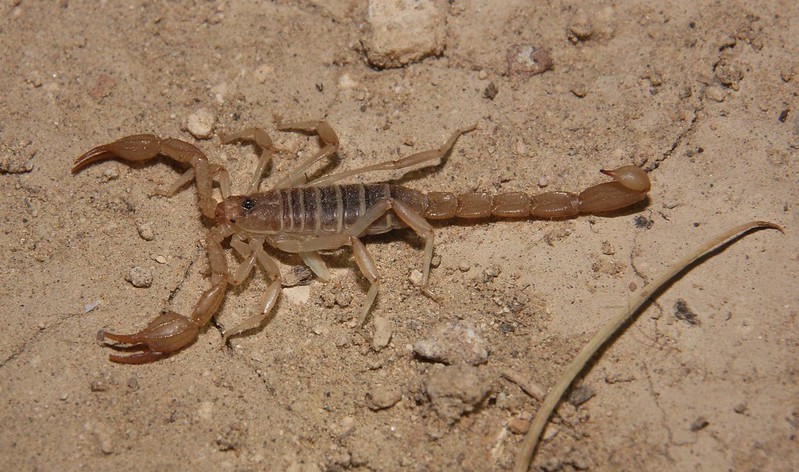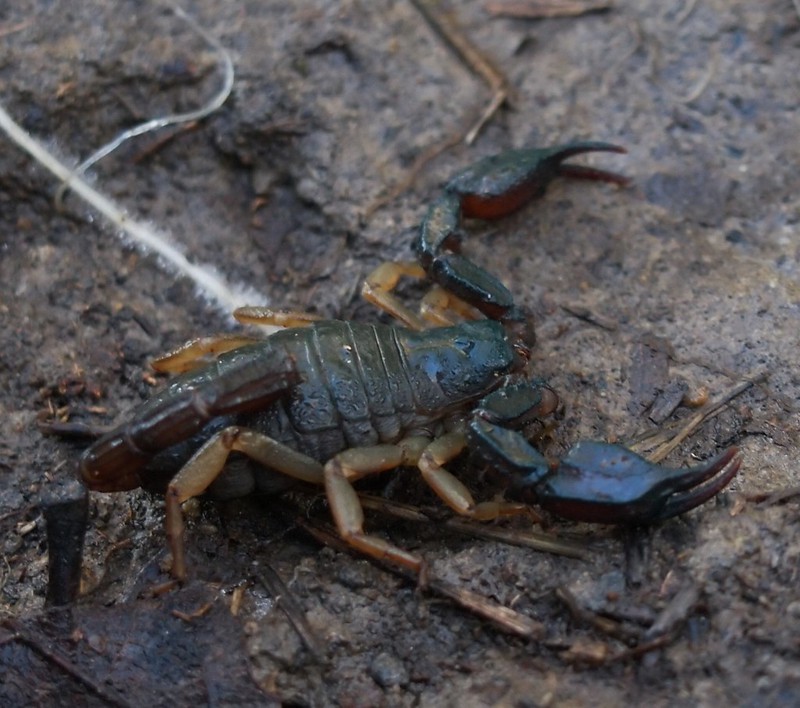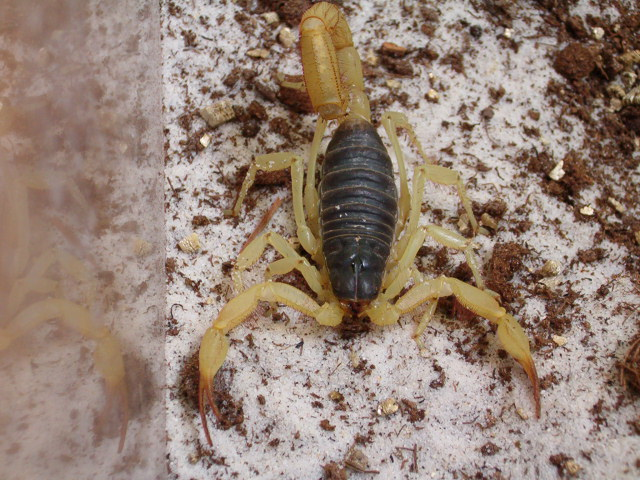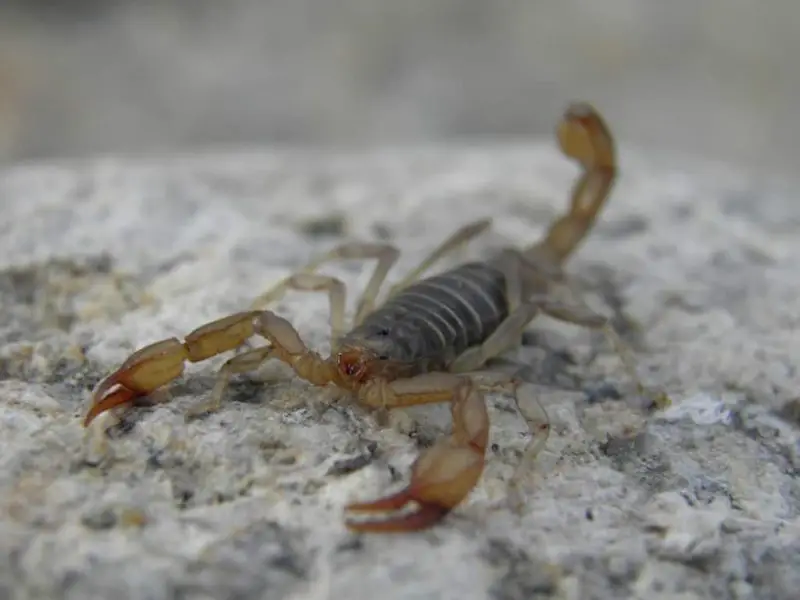When people think of scorpions, they generally think of the American desert southwest. There are plenty of scorpions there to choose from.
The Pacific Northwest isn’t the first region that comes to mind for likely scorpion habitat. However, the region has its scorpions too.
The state of Oregon is home to three types of scorpions. These are the Northern Scorpion (Paruroctonus boreus) and the Western Forest Scorpion (Uroctonus mordax), and the Northern Desert Hairy Scorpion or Black-Back Scorpion (Hadrurus spadix)
None of the three scorpions we’ll be talking about has a sting that is any more medically significant than a bee sting. However, all stings have the potential to cause a severe allergic reaction. If you have blurred vision or difficulty breathing after experiencing a scorpion sting, seek immediate medical attention.

The Northern Scorpion (Paruroctonus boreus)
The northern scorpion or boreal scorpion is a species of scorpion in the family Vaejovidae.
Northern scorpions are found in 12 U.S. states and 3 Canadian provinces. The northern scorpion species’ range begins in northern Arizona and goes north to southwestern Canada. In the United States, northern scorpions live in Arizona, California, Nevada, Utah, Idaho, Wyoming, Montana, North Dakota, South Dakota, Oregon, and Washington. In Canada, Northern Scorpions live in southern British Columbia, southern Alberta, and southern Saskatchewan. See
Northern scorpions are the most northern species of scorpion due to their ability to tolerate some cold. In fact, they are the only species of scorpion to live in Canada.
In Oregon, northern scorpions live almost entirely from central Oregon east.
What do northern scorpions look like?
All scorpions look a little bit like tiny land-dwelling lobsters with some distinctions. Lobsters have 10 legs, while scorpions have 8, and of course, lobsters don’t have bulbous venom-filled stingers on the end of their tail, while scorpions do.
Northern scorpions have segmented sections in their exoskeletons that range in color from light brown to dark brown. What’s more, they have a yellowish-colored, proportionately thin, long tail with a stinger on the tip and a lobster-like pair of pincers or pedipalps that do not function as legs. Instead, they use their pedipalps to capture and hold their prey. Northern scorpions are proportionatley large-clawed scorpions.
A rule of thumb on claw size is that larger clawed scorpions have less powerful venom. They need their larger pincers to help them subdue prey.
Northern scorpions are relatively small scorpions. An adult northern scorpion will be 35mm to 55mm (1.37 to 2.16 inches) long. Northern scorpions display sexual dimorphism, with females being consistently larger than males. See
Northern scorpions are nocturnal creatures, meaning that they come out and are active at night. Inversely, they are mostly inactive during the day.
As most scorpions do, they have fluorescent compounds in their exoskeletons that make them glow under black light. If you are camping in an area where northern scorpions are active, it’s a good idea to go armed with an ultraviolet flashlight. Use the UV light to scan your campsite after dark, after 9:30 PM to be exact.
Although the venomous sting from a northern scorpion generally isn’t very dangerous, it still wouldn’t do to share your sleeping bag with one. Like all scorpions, northern scorpions are nocturnal hunters. As such, they will be out and about after dark, searching for small prey such as grasshopper nymphs.
Northern Scorpion Behavior
Like most scorpions, northern scorpions are nocturnal. In fact, they are most active between 9:30 PM and 11:00 PM. If they have not come out of their burrows by 11:00 PM, it is unlikely that they will immerge to feed that night. Additionally, they will not come out of their burrows to hunt during a rainstorm and are much less active for 3 to 5 days after a rainstorm.
The Northern scorpion is a burrowing scorpion. As such, they are similar to other North American burrowing scorpions, such as the Northern Desert Hairy Scorpion, in that they seldom venture more than a dozen feet from their lairs to hunt. In the fall season, it’s not uncommon for them to move inside some manmade structure to live out the months of cold weather. However, they usually hibernate through the winter months in their underground burrows.
The percentage of the time that northern scorpions utilize their venom to subdue their prey falls dramatically with the age of the scorpion. Northern scorpions that are less than two months old use their stingers each time they subdue prey. On the other hand, adults which have more strength in their pedipalps only use their stingers around 30% of the time. The other 70% of the time, they opt to subdue their prey using only their pedipalps to grasp it until it ceases to struggle. See
Northern scorpions are born alive. When the female gives birth, she assumes a sitting position on her hind legs. She will give birth to 10 to 40 young.
After the newborn northern scorpions free themselves from the birth membrane, they will climb up their mother’s walking legs and onto her back. They will ride there on the back of the female in a grouped formation, only climbing down to feed on pellets that their mother creates for them when she feeds until they are sufficiently old to strike out on their own. See
Are Northern Scorpions Dangerous?
Unlike the Arizona Bark scorpion, for example, which is the most venomous scorpion in North America, Northern scorpions are not particularly dangerous to humans.
Northern scorpions seldom sting humans. They reserve their venom to subdue their prey animals which include small insects and arachnids. What’s more, the sting from a northern scorpion is no more dangerous than a wasp sting.

Northwest Forest Scorpion (Uroctonus mordax)
The Northwest Forest scorpion goes by more than one common name. They’re also called the Western Forest Scorpion, the Pacific Forest Scorpion, Pacific Northwest Forest Scorpion, or the California Forest Scorpion.
In appearance, western forest scorpions are around 2 inches long. Their bodies are either black or dark brown, while their legs are semitransparent yellowish brown. Their tails are proportionately long and thin compared to other scorpion species. On the other hand, they have proportionately large pincers.
These scorpions live for around ten years in the wild.
Northwest Forest scorpions live primarily in western Oregon, on the west side of the Cascade Mountains, in the Siskiyou, the Klamath Mountains, and the Willamette Valley. They also exist in both the Oregon and Washington state sides of the Columbia River gorge.
This little scorpion likes moist environments, more so than most scorpion species. Look for them on heavily forested, west-facing slopes. Their hiding places include leaf litter, the space underneath flat rocks and logs, and the crevasses between talus rocks.
Although they have the ability to sting you, these scorpions will usually either play dead or hide rather than sting defensively unless, of course, they’re trapped against your skin, like, for instance, in a shoe.
In a 2019 KMTR interview found here, Oregon Department of Agriculture Entomologist Jim Labonte, who has the distinction of being stung by a northwest forest scorpion, stated that the sting is less painful and less long-lasting than that of a honeybee.
Uroctonus mordax are shy scorpions. They are nocturnal hunters and are even less likely to be out hunting when there is excessive moonlight. Like most scorpions, northwest forest scorpions’ exoskeletons glow under black light. If you want to find one, you may need to try looking with a UV flashlight on a moonless night.

Black-back Scorpion (Hadrurus spadix)
The Black Back Scorpion or Northern Desert Hairy Scorpion, is closely related to the more common desert hairy scorpion (Hadrurus arizonensis).
These are fairly large as scorpions go. As adults, they are up to 5 1/2 inches long. They are by far the largest scorpion found in the state of Oregon. They have dark gray to black bodies while their undersides, legs, claws, and tail are all yellow. The tops of their backs are black. This dark-colored back is one way to differentiate between them and the giant hairy desert scorpion. One more defining characteristic of the black-back scorpion is that their bodies are covered with fine hairs.
Northern desert hairy scorpions are large enough to capture small rodents and lizards.
Black-back scorpions are burrowing scorpions. Consequently, you’re more likely to find them in areas with loose sandy soils.
These Scorpions live in Arizona, Nevada, Southern Oregon, and Southern Idaho.
Look for these scorpions in the high desert region of southeastern Oregon.
Also see:
Scorpions in Colorado – Krebs Creek
Scorpions in Idaho – Krebs Creek
Scorpions in North Dakota – Krebs Creek
Scorpions in Montana – Krebs Creek
Scorpions in Wyoming – Krebs Creek
Scorpions in Alberta – Krebs Creek
Recent Posts
The only venomous snakes in Washington State are Northern Pacific Rattlesnakes. The Northern Pacific Rattlesnake (Crotalus oreganus oreganus) is a sub-species of the Western Rattlesnake. Anyone...
Skunks are not classified as true hibernators. But they go into a state of torpor when the weather gets cold. Skunks are light sleep hibernators, along with opossums, bears, and raccoons. ...

